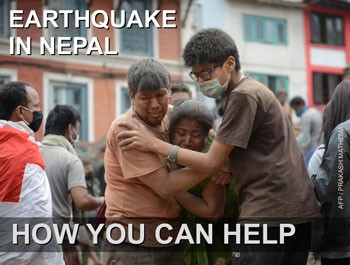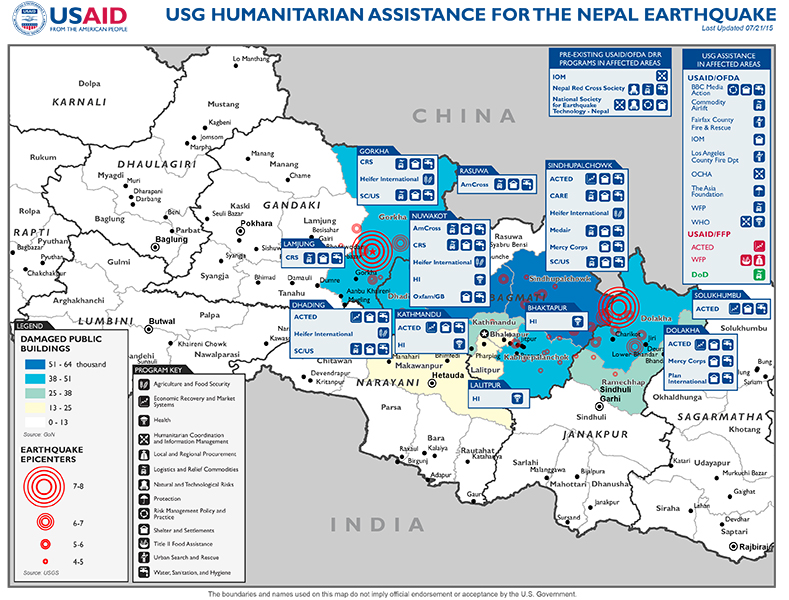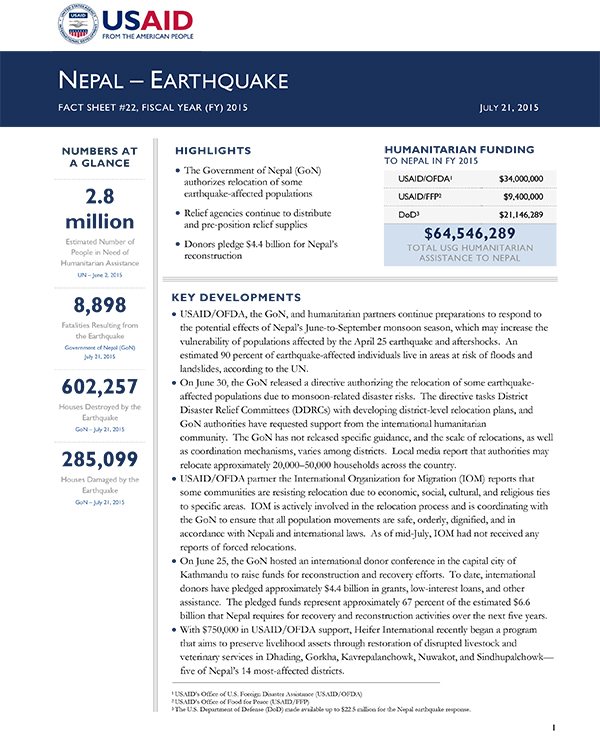Speeches Shim
July 21, 2015
Highlights
The Government of Nepal (GoN) authorizes relocation of some earthquake-affected populations
Relief agencies continue to distribute and pre-position relief supplies
Donors pledge $4.4 billion for Nepal's reconstruction
Key Developments
USAID/OFDA, the GoN, and humanitarian partners continue preparations to respond to the potential effects of Nepal’s June-to-September monsoon season, which may increase the vulnerability of populations affected by the April 25 earthquake and aftershocks. An estimated 90 percent of earthquake-affected individuals live in areas at risk of floods and landslides, according to the UN
Nepal Map 07-21-2015 ![]() (pdf - 1013k)
(pdf - 1013k)
Numbers At A Glance
2.8 million
8,898
602,257
285,099
Humanitarian Funding:
To Nepal To Date In FY2015:
| USAID/OFDA | $34,000,000 |
| USAID/FFP | $9,400,000 |
| DoD | $21,146,289 |
| TOTAL | $64,546,289 |
Nepal Earthquake Fact Sheet #22 - 07-21-2015 ![]() (pdf - 216k)
(pdf - 216k)
On June 30, the GoN released a directive authorizing the relocation of some earthquakeaffected populations due to monsoon-related disaster risks. The directive tasks District Disaster Relief Committees (DDRCs) with developing district-level relocation plans, and GoN authorities have requested support from the international humanitarian community. The GoN has not released specific guidance, and the scale of relocations, as well as coordination mechanisms, varies among districts. Local media report that authorities may relocate approximately 20,000–50,000 households across the country.
USAID/OFDA partner the International Organization for Migration (IOM) reports that some communities are resisting relocation due to economic, social, cultural, and religious ties to specific areas. IOM is actively involved in the relocation process and is coordinating with the GoN to ensure that all population movements are safe, orderly, dignified, and in accordance with Nepali and international laws. As of mid-July, IOM had not received any reports of forced relocations.
On June 25, the GoN hosted an international donor conference in the capital city of Kathmandu to raise funds for reconstruction and recovery efforts. To date, international donors have pledged approximately $4.4 billion in grants, low-interest loans, and other assistance. The pledged funds represent approximately 67 percent of the estimated $6.6 billion that Nepal requires for recovery and reconstruction activities over the next five years.
With $750,000 in USAID/OFDA support, Heifer International recently began a program that aims to preserve livelihood assets through restoration of disrupted livestock and veterinary services in Dhading, Gorkha, Kavrepalanchowk, Nuwakot, and Sindhupalchowk— five of Nepal’s 14 most-affected districts.
HUMANITARIAN ACCESS AND LOGISTICS
The UN reports that customs delays and taxation of aid arriving in Nepal are preventing humanitarian assistance from reaching communities. Director of Operations for the UN Office for the Coordination of Humanitarian Affairs (OCHA) John Ging recently reported backlogs of essential shelter materials, sufficient to assist approximately 100,000 families, at Kathmandu’s Tribhuvan International Airport and at land border crossings. While no national solution has been reached, some non-governmental organizations (NGOs), including USAID/OFDA partners, have reported obtaining clearances on relief items on a case-by-case basis. Additionally, blocked roads and damaged infrastructure continue to impede relief actors’ efforts to reach remote villages in need of humanitarian assistance.
USAID/OFDA is supporting the GoN, the UN, and NGO partners to develop contingency plans, distribute supplies, and pre-position additional emergency relief commodities for earthquake-affected populations, as well as populations in areas at risk of flooding. The UN is also preparing a response strategy for flooding—including operational guidance and key response sectors—in 18 flood-prone districts outside of earthquake-affected areas.
On July 13–15, USAID/OFDA staff traveled to Dolakha and Sindhupalchowk districts to assess the humanitarian situation; meet with earthquake-affected populations, partner organizations, and local GoN authorities; and observe USAID/OFDA-funded response activities. In both Dolakha and Sindhupalchowk, USAID/OFDA partner Mercy Corps continues to provide cash assistance and emergency relief commodities to earthquake-affected populations. However, the monsoon rains have restricted humanitarian access to some areas, and the Nepal Red Cross Society reported challenges reaching northern communities due to road blockages.
To meet the humanitarian needs of earthquake-affected households and ensure continued support during the monsoon season, USAID/OFDA has committed more than $9.8 million to provide relief items and strengthen logistical capacity in Nepal following the April 25 earthquake.
DISPLACEMENT AND SHELTER
Providing adequate shelter for earthquake-affected households remains a key priority in Nepal, as many families continue to live in makeshift housing that may not withstand the monsoon rains. As of July 21, an estimated 59,400 people displaced by the earthquake continued to shelter in 104 displacement sites, according to IOM. The Shelter Cluster—the coordinating body for humanitarian shelter activities, comprising UN agencies, NGOs, and other stakeholders—reported that relief actors had distributed or would soon distribute nearly 700,000 tarpaulins, more than 300,000 blankets, and approximately 19,000 tents to earthquake-affected families in Nepal as of July 3.
Local media recently reported that the Gorkha DDRC has initiated the temporary relocation of nearly 1,750 households due to high landslide risk. OCHA reported on July 17 that the Dhading, Gorkha, Nuwakot, and Sindhupalchowk DDRCs are finalizing plans to relocate between 1,800 and 2,200 households per district under the June 30 GoN directive. Local media also reported that the GoN is requiring an estimated 800 earthquake-affected individuals in Tundikhel—a large, grassy area in Kathmandu city—to vacate their makeshift shelters by the end of July.
Heavy rains on July 1 caused flooding at Chuchepati displacement site in Kathmandu—one of the city’s largest sites, sheltering approximately 8,000 earthquake-affected people. IOM responded by mobilizing equipment and volunteers to improve drainage at the site.
To date, USAID/OFDA has provided nearly $7.5 million to support shelter interventions across earthquake-affected districts of Nepal.
HEALTH
USAID/OFDA is supporting the UN World Health Organization (WHO) to establish disease surveillance systems in earthquake-affected areas to detect and respond rapidly to potential disease outbreaks during the coming months. The UN Children’s Fund (UNICEF) is also pre-positioning relief items to address potential cases of cholera and other diarrheal diseases.
The Health Cluster continues to assist earthquake-affected populations in need of medical assistance but is beginning to also focus on the rehabilitation of health services and facilities. A July 3 Health Cluster report estimated that the earthquake caused $75.4 million in health sector-related damages and losses, with more than 1,200 public health facilities damaged or destroyed. The GoN Ministry of Health and Population (MoHP) has established an early recovery working group to coordinate with partners who plan to support the ministry in reconstructing damaged health facilities.
FOOD SECURITY AND NUTRITION
More than 1 million people continue to require food assistance to meet daily dietary requirements, according to a July 7 UN report. As of July 8, UNICEF had provided micronutrient powders designed to prevent nutritional deficiencies to nearly 162,000 Nepalese children younger than five years of age in 2015. Between June 28 and July 4, UNICEF coordinated with the MoHP to deliver essential nutrition services to more than 50,000 women and children in the 14 most severely earthquake-affected districts as part of Child Nutrition Week.
USAID/FFP recently provided $2.5 million to the Agency for Technical Cooperation and Development (ACTED), which plans to provide food assistance to approximately 2,250 food-insecure households, as well as short-term livelihoods support, in five of Nepal’s most earthquake-affected districts. ACTED’s livelihoods program includes providing agricultural kits and harvest storage units to earthquake-affected families and implementing cash-for-work programming to create employment opportunities for an estimated 5,650 vulnerable households.
Since June, the UN World Food Program (WFP) and partner organizations the Nepal Red Cross Society and Save the Children/U.S. (SC/US) have distributed cooking oil, lentils, and rice to disaster-affected communities in Sindhupalchowk. As of July 15, WFP had provided food assistance to more than 2.7 million people in Nepal since April 25. To date in FY 2015, USAID/FFP has provided $6.9 million in support to WFP for the Nepal earthquake response.
WASH
As of June 29, an estimated 3 million people in Nepal remained in need of hygiene interventions, more than 1 million people lacked access to safe drinking water, and approximately 1 million people were in need of sanitation support due to the earthquake, according to OCHA. In response, the Water, Sanitation, and Hygiene (WASH) Cluster is constructing latrines, distributing emergency water and water treatment kits, promoting good hygiene practices, and repairing water systems.
As of July 9, the UN reported that WASH Cluster partners have reached more than 2 million people with emergency water interventions—including distributing water containers and treatment products—and nearly 270,000 people with sustained water interventions, such as rehabilitated water systems. WASH Cluster partners have also assisted more than 1 million people with hygiene interventions, including distributing hygiene kits.
To date, USAID/OFDA has provided more than $3 million to meet earthquake-related WASH needs in Nepal.
INTERNATIONAL ASSISTANCE
As of July 21, the USG had provided more than $64.5 million for earthquake response efforts in Nepal, while other international donors had provided more than $357 million, according to the UN. The ongoing UN flash appeal is funded at approximately $198 million—47 percent of the $422 million requested.
CONTEXT
On April 25, a magnitude 7.8 earthquake struck Gorkha in central Nepal, approximately 48 miles northwest of Kathmandu city, at a shallow depth of approximately nine miles, according to the U.S. Geological Survey (USGS).
The USG immediately issued a disaster declaration for Nepal due to the effects of the earthquake. Within hours of the seismic event, USAID/OFDA activated a Response Management Team in Washington, D.C., and deployed a Disaster Assistance Response Team (DART)—including urban search-and-rescue (USAR) specialists—to Nepal.
On May 12, a magnitude 7.3 aftershock struck Dolakha, approximately 47 miles northeast of Kathmandu city, according to USGS. The aftershock caused further casualties and damage in areas affected by the April 25 earthquake.
For nearly two decades, USAID/OFDA has supported disaster risk reduction (DRR) efforts in Nepal, including in Kathmandu Valley. USAID/OFDA funding has enabled partners to identify, prepare, and preserve more than 80 open spaces in Kathmandu Valley for humanitarian purposes; pre-position critical emergency relief supplies; and strengthen earthquake response capacity at the local and national levels in collaboration with the GoN, NGOs, private companies, and local communities. More information on USAID/OFDA’s DRR programs in Nepal and throughout South Asia is available at www.usaid.gov/what-we-do/working-crises-and-conflict/disaster-risk-reduc....
PUBLIC DONATION INFORMATION
The most effective way people can assist relief efforts is by making cash contributions to humanitarian organizations that are conducting relief operations. A list of humanitarian organizations that are accepting cash donations for disaster responses around the world can be found at www.interaction.org.
USAID encourages cash donations because they allow aid professionals to procure the exact items needed (often in the affected region); reduce the burden on scarce resources (such as transportation routes, staff time, and warehouse space); can be transferred very quickly and without transportation costs; support the economy of the disaster-stricken region; and ensure culturally, dietary, and environmentally appropriate assistance.
More information can be found at:
- The Center for International Disaster Information: www.cidi.org or +1.202.821.1999.
-
Information on relief activities of the humanitarian community can be found at www.reliefweb.int.




Comment
Make a general inquiry or suggest an improvement.